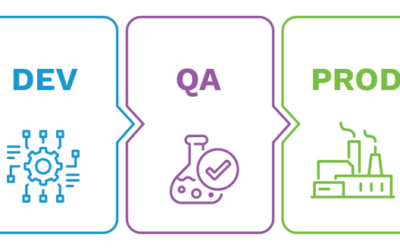Automate Business Processes: Replace Human Effort with Machine Tasks
In the six-step journey to transform a manual fulfillment workflow process to a fully automated process, the leap from Stage 3 to Stage 4 is a big one.
A Focus on Stage 3 & Stage 4
Automating business processes from manual to fully automated workflows requires a series of steps. Based on our experience across many large enterprises, it’s a journey through six individual stages, as defined in the Kinetic Automation Maturity Model (KAMM).
One of the biggest leaps on that path is taking a process from Stage 3 to Stage 4, as noted in our discussion of the KAMM framework:
“Above that line (separating Stages 1-3 from Stages 4-6), fulfillment requires a human brain process; a human is figuring out what to do. Below that line, the system has stored the definition and map of the process, so it is moving through the process steps automatically rather than relying on a human brain.”
When it comes to business process automation, request fulfillment processes are evaluated in Stage 2. Those which are either high-volume or have compliance implications (or both) are generally moved to Stage 3. Most Stage 3 processes will be moved to Stage 4, with the exception of the items noted below.
Here’s a quick refresher on what the Stage 3 process is, the definition of Stage 4, the benefits and risks of making the transition, and an example for illustration purposes.
Automating business processes: Stage 3 of KAMM
At Stage 3, process definitions are moved from human brains into software systems. You can also think of this as automating business process.
It starts with whiteboarding sessions to map out the fulfillment process as stored in the brain of the human(s) doing the fulfillment. These process steps are then optimized and entered into a system.
From that point on, although fulfillment tasks are still performed manually, the process is managed by a system. The system instructs the human fulfiller what to do at each process step and provides the information needed to complete each specific step.
The benefits of moving processes from Stage 2 to Stage 3 include:
- cost reduction (typically by about one-third)
- improved process consistency and scalability
- simplified training for fulfillers
Business Process Automation Frustration at Stage 3: Swivel Chair
Although a system is managing the overall fulfillment process at Stage 3, a human is still typically performing each of the task steps. A step may often look something like checking off the completion of a task in a ticket management system, updating a record in the financial software and then returning to the first system to close out the ticket.
In Stage 4, closing out the ticket automatically updates the record in the finance system, so the swivel chair is eliminated. Employees save time and stay “in the flow” because they aren’t switching back and forth between software platforms.
Why Organizations May Keep Some Processes at Stage 3
Generally, most business processes that are moved to Stage 3 will be transitioned into Stage 4. Once the process has been mapped out and digitized, it’s natural to automate many of those manual steps and eliminate the swivel chair.
But there are two types of exceptions where an organization may choose to keep some processes at Stage 3. The first is when the process includes steps that are very difficult to automate. It just may not be worth the effort in the long run, especially if the volume isn’t very high and the process isn’t terribly costly.
The second situation occurs when a process involves updating records or recording transactions in a legacy system or platform, such as a mainframe. The integration may be just too difficult and painful to be worthwhile. But again, most Stage 3 processes will naturally be transitioned to Stage 4.
What is Stage 4?
At Stage 3, a human may be working a ticket in their workflow platform, then log into a separate system such as Salesforce.com to apply a discount code, then return to their workflow platform to close out the ticket.
But at Stage 4, the systems are integrated and the discount-code-application step is coded into the workflow process. So, once that human closes out the ticket, the workflow platform automatically updates that record in Salesforce. Instead of assigning tasks to humans, those tasks can be performed via an API.
Automating Business Processes: Stage 4
Stage 4 is all about the API economy and about API consumption. The more systems your organization has behind the scenes that expose an API, the more software applications you have that can participate in the completion of workflow tasks. Leveraging APIs is what Stage 4 (as well as Stages 5 and 6) is all about.
As a simple example, an organization could have a machine that does approvals. Approvals are assigned to an application instead of a human. The software uses AI or rules-based logic to make or deny approvals, with human involvement required only for exceptional cases.
Benefits of Moving from Stage 3 to Stage 4
There are numerous benefits of transitioning Stage 3 processes to Stage 4. Two of the biggest benefits, as with automation generally, are in saving time and costs. Per the KAMM framework, moving processes to Stage 4 reduces overall completion time from weeks to days… or even from days to hours.
It also cuts the typical cost of a process in half. Having machines perform request fulfillment tasks instead of humans is more efficient. A computer doesn’t have to “wait until it has time” to perform a task, and it can complete most add/change/delete tasks essentially instantaneously.
Beyond saving time and money on the actual process of fulfillment, the benefits of moving processes to Stage 4 – or automating business processes – include:
Eliminate the swivel chair: A third benefit is that, as noted above, the swivel chair is eliminated at Stage 4. This improves not only employee productivity but also job satisfaction, since they are able to stay in the flow. It also reduces the risk of errors, improving process consistency and accuracy.
Reduce software license costs: Yet another benefit is license cost avoidance. If your hundreds or even thousands of service center employees no longer need licenses for your CRM, finance, or other systems because the software is making the required updates automatically via API integrations, the savings in license costs can be enormous.
Improve analytics and visibility: With process tasks being completed by machines instead of humans, visibility is dramatically improved. It’s easier to see exactly where fulfillment of a specific request is in the process, how long specific tasks as well as overall processes are taking to complete, and where bottlenecks are cropping up. All of these expose opportunities for process improvement.
Increase scalability: There are natural limits to how fast humans can work. If thousands of orders need to be placed manually, they’ll either take a long time or simply not get done without hiring more people. But a computer can place thousands of orders, quickly and easily.
Avoid vendor lock-in: If you have five or 10 or X ways that your workflow platform is interacting with a system (e.g., SAP, BambooHR or BMC Remedy), it simplifies your testing and analysis of a potential replacement system (e.g., Oracle, Workday or ServiceNow). If these X tasks can work in the new system, then all of your existing processes that call those X tasks can work, too.
If you want to switch the API to transition from BambooHR to Workday or from Remedy to ServiceNow, you can do it. No one needs to know the difference up front; the changes are only on the back end. You could even create both a Remedy ticket and a ServiceNow ticket for a given period of time and work the issue in both to see if you’re happy with the new system.
If it does the trick, you can eventually disable the Remedy API and work all tickets in ServiceNow. You’re able to experiment with different back-end systems without changing the front-end interface or workflow. No one at the front end knows the difference. So, you get seamless architectural flexibility.
Reduce training and documentation costs: If your entire team is working directly in an enterprise software platform such as SAP, and SAP comes out with a new version — you may have to retrain everyone on how to perform 10, or 20 or X processes, because they’ll work differently now.
You also have to update all of your supporting documentation to reflect this change, and make sure to replace every copy of the old documentation to avoid confusing your people.
But if you have your entire team, everyone at your facility or 10,000+ employees across your company filling out forms and hitting “SAVE” in your front-end workflow system, then the fact SAP now does something differently is irrelevant to them. No one needs to change their behavior. That is a huge benefit.
Enable and support change: In the same way Stage 4 processes allow architectural flexibility, they also permit changing the way tasks or workflow sequences are done on the back end without changing the way your people work on the front end.
So you can improve your inventory management, pricing, shipping practices — whatever — without forcing anyone at the front end of these processes to do things differently. It’s all gain, no pain.
Risks at Stage 4
There’s little risk in moving Stage 3 processes to Stage 4. It’s true that when machines are doing the work instead of humans, your people will come to rely on the technology over time and lose the skills to complete these processes manually.
But the risk of vital fulfillment process knowledge “walking out the door” is actually greater at Stage 3, when humans are still performing most of the tasks. At Stage 4, these tasks are documented and coded in the system, reducing that risk.
Additionally, there’s little risk of losing oversight or control for compliance and auditing. At Stage 4, machines are doing the work, leaving a digital audit trail as tasks are completed. If anything does go wrong, it should be easier to spot and correct at Stage 4 than at earlier stages.
There is some risk of a workflow process “breaking” at Stage 4 because a back-end system gets upgraded. The new version may use different terminology (e.g., “priority” rather than “severity”) or add a new required field. But again, because of the process documentation and visibility, it should be relatively easy to find where the process is broken, fix it in the front-end workflow platform, and then resume business as usual.
A Stage 3 to Stage 4 Example: Corporate Laptop Configuration
A common request type across organizations is for new laptop configuration. A new employee joins the company and needs a laptop pre-configured with the required software to perform the tasks that are part of that role.
In Stage 3, a fulfillment employee would have to take a laptop out of inventory, look up the software requirements for the new employee’s role, and then manually install and configure the needed applications.
At Stage 4, the new laptop would get plugged in, connected to the network, and then based on the role selected, the system would automatically configure and install all of the required software.
How the Kinetic Platform Supports the Move from Stage 3 to Stage 4
In Stage 4, systems of record play a vital role. The Kinetic Platform serves as the “glue” across these systems, orchestrating tasks among them. It provides the ability to automate fulfillment processes regardless of the back-end systems in use.
The Kinetic Platform enables your organization to take a low-risk, lower-cost “embrace and extend” approach to process automation rather than requiring a disruptive, time-consuming “rip and replace” project.
It also supports different approaches to process automation. One approach is for your fulfillment team to do all of their work in the Kinetic Platform. It then communicates with various back-end systems of record to complete tasks and update records.
Another scenario is when you’ve already got great workflows built within other systems. In that case, the end user makes a request in the Kinetic Platform, which then sends a ticket to SAP, or ServiceNow, or another back-end fulfillment system of record.
Once that ticket is completed and closed out in the back-end system, it sends a message to the Kinetic Platform which then performs the next step or notifies the end user that the process is complete.
The Kinetic Platform enables you to put a simple, intuitive interface onto functions performed in other systems. No one has ever said, “That SAP interface sure is nice.” One example might be providing retail store employees with a user-friendly mobile interface into the company’s back-end SAP system.
Exposing only the fields and elements that are absolutely necessary to complete a task not only simplifies training and accelerates process completion; it also reduces opportunities for error.
Reflecting the “avoid vendor lock-in” and “reduce training costs” benefits of Stage 4 processes as outlined above, the Kinetic Platform makes it easy to modify processes to accommodate a field name change or new required field when updating systems of record. And it’s designed to let you swap out API connections quickly and seamlessly.
Let’s Sum Things Up
In the six-step journey to transform a manual fulfillment workflow process to a fully automated process, the leap from Stage 3 to Stage 4 is a big one. It marks the point at which fulfillment tasks start to be performed by machines instead of humans.
Although most Stage 3 processes will eventually be transitioned to Stage 4, those which involve either difficult-to-automate manual tasks or difficult-to-integrate legacy systems may be left at Stage 3.
Transitioning processes from Stage 3 to Stage 4 provides a number of benefits, reducing fulfillment time and costs as well as eliminating the swivel chair so employees can stay in a less stressful and more productive flow stage. It also cuts licensing and training costs, helps avoid vendor lock-in, improves process visibility, and increases scalability.
The Kinetic Platform supports the move to Stage 4 by serving as the orchestration “glue” between various back-end systems of record. It enables fulfillment workers to complete tasks across multiple back-end systems from one simple, intuitive interface, accelerating workflows while reducing training costs and the risks of system upgrade disruptions. And it provides organizations with a cost-effective “embrace and extend” approach to process automation rather than forcing an expensive and disruptive “rip and replace” effort.
If automating business processes is high on your priority list, contact us today. Learn how the Kinetic Automation Maturity Model (KAMM) transforms your manual business processes to fully automated processes that save time and increase efficiency.



